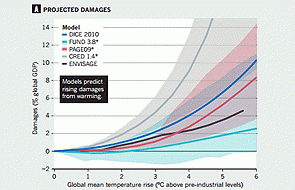
By Luke Harrington and Catherine Leining*


The ‘social cost of carbon’ (SCC) is the estimated cost of the damage caused by each additional tonne of carbon dioxide (or its equivalent) released into the atmosphere.
In practical terms, it tells us how much money we can save from avoided damages when we reduce each tonne of greenhouse gas emissions.
The SCC is a metric used by governments, researchers, companies and others to guide decision making about how much to invest in reducing greenhouse gas emissions.
Last year a US government working group, using three leading economic models, reported a central SCC estimate of US$37 per metric tonne of CO2 in today’s dollars.
This fell within a range from US$11 to US$57, depending on the discount rate and with a high-climate-impacts value of US$109 (all for emissions in 2015). The SCC would be expected to rise over time.
Emission prices under the New Zealand Emissions Trading Scheme currently are well below this range.
However, in a paper published on 10 April 2014 in the leading peer-reviewed journal Nature, Professor Richard Revesz from New York University and distinguished co-authors argue that current values reported for the SCC are underestimated, due to inherent assumptions that current climate-economic models make about the time-dependence of future climate change and limited proliferation of economic impacts.
The authors of this paper offer four key points to support their hypothesis:
1. The impacts of historical temperature changes, coupled with increased weather variability, may be higher than current climate models anticipate, particularly considering tipping points where crop yields may rapidly decline above a certain temperature threshold.
2. The models do not account for damages to labour productivity, productivity growth and the value of capital stock (e.g. infrastructure and buildings), nor do they consider the potential for social conflicts from climate change. These damages could lower annual economic growth rates, not just static economic output, thereby having more significant long-term consequences than are currently accounted for.
3. The models assume the value attached to ecosystems will remain constant over time. However, it is likely that ecosystem services will, on average, degrade over time with continued warming, suggesting that the costs of future ecosystem damage from climate change will increase at a faster rate than models predict.
4. The US government’s analysis applies a constant discount rate to express the present value of future economic damages. Other economic analysis suggests it would be more appropriate to apply a declining discount rate over time given the high uncertainty attributed to long-term impacts. A revised approach would instead yield a higher value for an estimated SCC.
The authors also emphasise that the damage functions in these climate-economic models are not calibrated for temperature increases beyond 3°C above pre-industrial levels. Given the RCP8.5 scenario of the latest IPCC report indicates that business-as-usual activity could lead to temperature increases exceeding 4oC by 2100, this uncertainty in modelling damages for extreme scenarios remains a serious knowledge gap.
While acknowledging the potential for uncounted biases in the other direction, the authors conclude that the SCC is likely underestimated in the US government analysis.
Despite methodological uncertainties in the precise calculation of the SCC, multiple economic studies (e.g. Stern 2007, Nordhaus 2013) conclude that the long-term economic damages from greenhouse gas emissions would far outweigh the cost of reducing those emissions. Pricing emissions effectively in the market would help to create efficient economic incentives to reduce emissions and avoid costly climate change damages.
In this context, it is important to recognise that models used to calculate what level of emission prices will eventually help prevent dangerous climate change assume that global agreements will be complete and efficient. Given that we know such agreements will be incomplete for a long time and policies will be inefficient, we will need higher emission prices when they are eventually applied at broad scale to make up for this efficiency deficit. This suggests that we would stand to gain in the long term by introducing higher emission prices now.
Improving the estimation of the SCC could help policy makers, researchers, companies and households to better understand the full value of reducing greenhouse gas emissions. Boosting collaborative and interdisciplinary research to improve the design of climate-economic models and broaden agreement on key assumptions represents a critical next step in this process.
--------------------------------------------------
Luke Harrington is a PhD student at Victoria University of Wellington and the chief blogger for New Zealand’s Low-Emission Future, hosted by Motu Economic and Public Policy Research. Catherine Leining is a Policy Fellow at Motu. The views expressed are their own. This article was first published here.
4 Comments
The 4 points:
No 1, There's a "maybe" in there.
No 2, "Potential for"......"Could lower"
No 3," It is likely"
No 4, "High uncertainty"
Maybe 2+2=4
There is potential for 2+2=4
Could 2+2 be less than 4.
It is likely that 2+2 = 4.
There is a high uncertainty that 2+2=4
Maybe lots of things are < missing >
Excellent piece of work. You as the up and coming generation will have to solve this problem. SCC seems like a good start, I'm sure better measures will be found but this is a good enough starting point.
The Climate Silence coalition will try to derail you, but they have demonstrated their lack of technical ability over and over.
Keep it up, a few of us grumpy old men will back you up.
We welcome your comments below. If you are not already registered, please register to comment.
Remember we welcome robust, respectful and insightful debate. We don't welcome abusive or defamatory comments and will de-register those repeatedly making such comments. Our current comment policy is here.